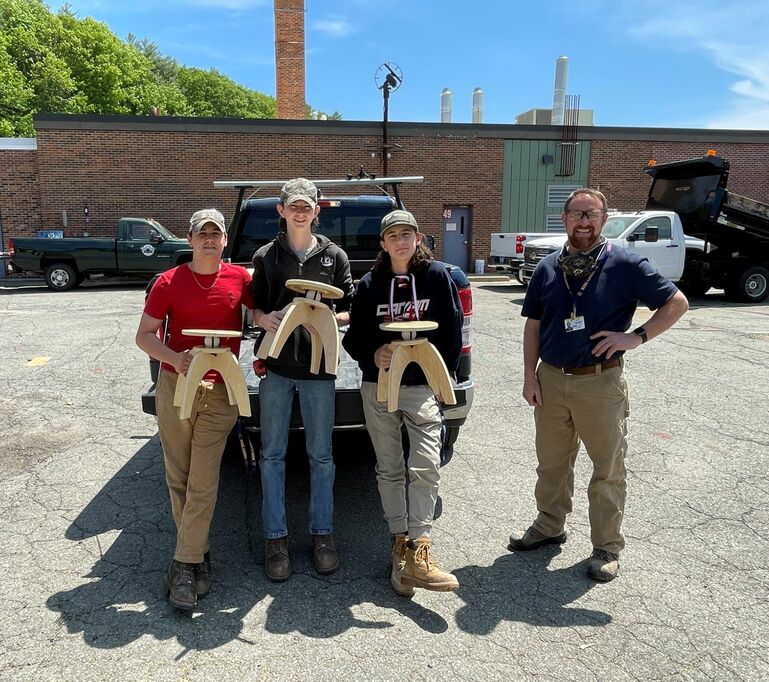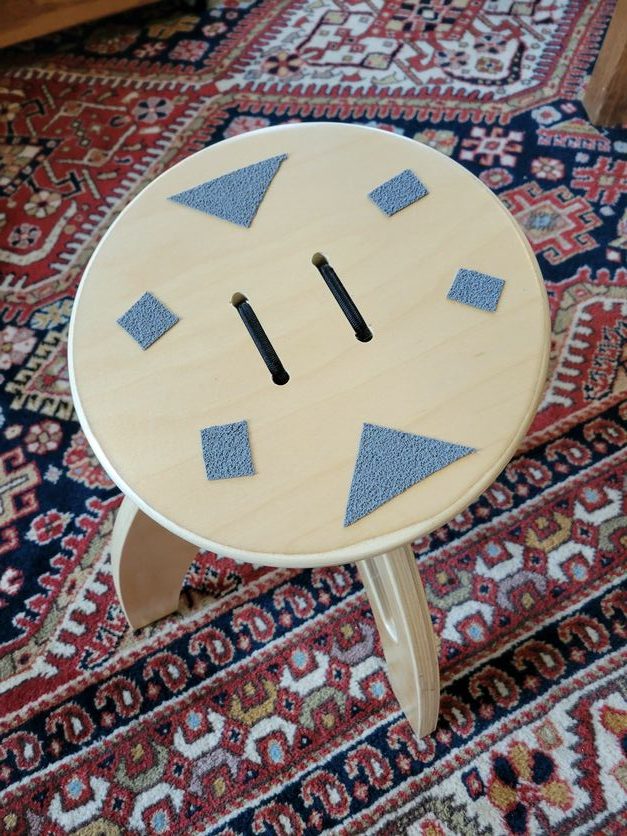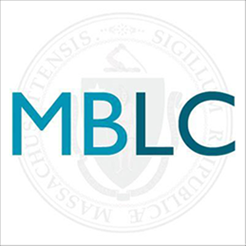Public libraries are for everyone, right? As we gain more knowledge about the needs of neurodiverse patrons, libraries are implementing new ways to serve this population. Here are two inspiring stories from our libraries in Royalston and Medford.
ButtOn Chairs Fidget in the Phinehas S. Newton Library (Royalston)
By Kathy Morris, Library Director

If you’ve never heard of ButtOn chairs, you are not alone. In the spring of 2021, Tom Musco, a Royalston timber framer, let me know about a TED talk by Dr. Turner Osler, a trauma surgeon who had left the operating room to become an epidemiologist and spent more time sitting. He got back pain. So, he began to look for a chair that would help and when he didn’t find one, he invented one. Wanting to share his idea, he made the plans available for free. Tom looked at the plans and asked if the Library would be interested in having some. One look at the chairs and the story behind them elicited an immediate yes. He then spoke to the Cabinetmaking instructor, Michael Dion, at the Montachusett Regional Vocational Technical School who was interested in the project for some of his students. Due to the pandemic, the price for the plywood had increased so that the original $5 price increased to $13 each, but that still seemed like a bargain. By the middle of June 2021, we were the recipients of some really cool chairs in two sizes. Kids were mesmerized by them and spent as much time squirming around on them as they did looking at books (sometimes more).
So, what do the chairs do? They allow ‘active sitting.’ As the QOR360 website states, active sitting refers to the idea that your spinal reflexes are free to adjust to your posture from moment to moment while in a seated position. About 80% of all Americans suffer from back pain that requires medical attention. If we can change the way we sit and move, we improve posture and strengthen the back.

This type of chair allows children to squirm as much as they want without leaving their seats. Perfect for the classroom where sitting is enforced. And even more beneficial for children diagnosed with ADHD. Osler sites research that there is evidence that a deficiency in sensory modulation may be the root cause. “The idea is that students who carry the ADHD label simply need additional sensory input, such as fidgeting, to appropriately respond to the world. In this view, facilitating additional sensory input by encouraging movement while seated in class could allow children and their families to avoid more onerous treatments such as stimulants.” The hyperactivity associated with ADHD can be channeled into chair motion.
Because we have preconceived notions of what a chair should look like, Osler felt the place to start was with children. Because of a patron, the free plans, and Monty Tech students and instructor, we were able to introduce them into the children’s room. Kids love them. Ours were slightly adapted from the original plan, in that a lacrosse ball was used instead of a tennis ball, and in emailing QOR, it has also changed to a lacrosse ball. The other thing we observed was that it is definitely active sitting. Both feet need to be on the floor or the child is on the floor. The seats are slippery and when I called the company, they told me that they had created a pad they attach to the seat. We decided that we would use a tape like you use on slippery steps. Many were like sandpaper and but we found one at the local hardware store, 3M® Safety-Walk Gray Indoor-Outdoor Tread – 2”, that felt rubbery. We cut different shapes and attached them and found it solved the slipping problem. My only regret; I didn’t order one for myself.
Sensory Room in the new Charlotte and William Bloomberg Medford Public Library
By Sam Sednek, Head of Youth Services
“We are not a quiet library” is an oft-repeated slogan at Medford Public Library, and we are decidedly not. There’s a particular level of noise that comes with joyful play and discovery and an abundance of children—we welcome it and promote it. However, noise impacts everyone differently and while we want jubilant toddlers to freely express themselves in the playspace, we also want our patrons with sensory sensitivities to find their place in the library too.
When we were designing the new Charlotte and William Bloomberg Medford Public Library, we made it clear that we needed a quiet space—not a study room (we have those too!) or a hall in which stern proctors glare out at anyone who dares to shuffle too loudly (do those exist still?). We needed something a little different. We wanted a smaller space that could be used by a family that wanted to snuggle up with a good book. We thought there should be a place where a nursing parent could snag a few extra moments with their child. And, of course, where our neurodiverse patrons could dim the lights and exist in our space with a little white noise, a lot less distraction, and a chance to rebalance.
Sensory spaces aren’t designed to be busy and sometimes less is more. The window in the sensory room looks out over a big tree, so the view is very peaceful. We have two soft, lightly rockable chairs and a small nook that allows someone to get away, feel contained, and have a space to themselves. The truly remarkable piece is the LED Bubble Tube— a light changing white noise machine that has truly captivated everyone. The stuffed animals move in and out of the room, but we have found that most of our stuffed animal collection definitely prefers the quiet space to the play space!
Our “Quiet Room” is still a work in progress as we find out how different people use it and how to support users who need it most, but we are so glad that it was a priority in our new library. We hope prioritizing accessibility will help us make an awesome library space for patrons we were unable to serve before. It has been amazing to watch and learn that everyone is enjoying a little quiet in the middle of our Not Quiet Library.
